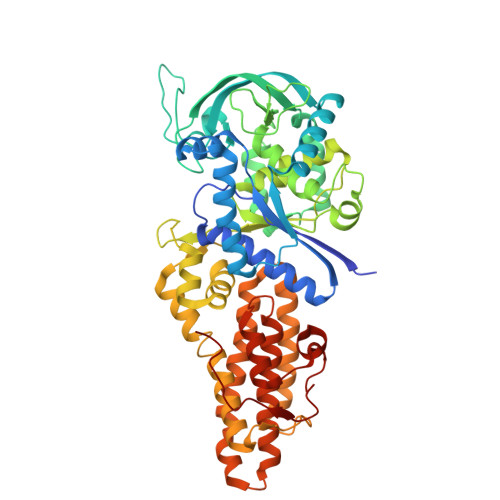Fragment screening and structural analyses highlight the ATP-assisted ligand binding for inhibitor discovery against type 1 methionyl-tRNA synthetase.
Yi, J., Cai, Z., Qiu, H., Lu, F., Luo, Z., Chen, B., Gu, Q., Xu, J., Zhou, H.(2022) Nucleic Acids Res 50: 4755-4768
- PubMed: 35474479
- DOI: https://doi.org/10.1093/nar/gkac285
- Primary Citation of Related Structures:
7WPI, 7WPJ, 7WPK, 7WPL, 7WPM, 7WPN, 7WPT, 7WPX, 7WQ0 - PubMed Abstract:
Methionyl-tRNA synthetase (MetRS) charges tRNAMet with l-methionine (L-Met) to decode the ATG codon for protein translation, making it indispensable for all cellular lives. Many gram-positive bacteria use a type 1 MetRS (MetRS1), which is considered a promising antimicrobial drug target due to its low sequence identity with human cytosolic MetRS (HcMetRS, which belongs to MetRS2). Here, we report crystal structures of a representative MetRS1 from Staphylococcus aureus (SaMetRS) in its apo and substrate-binding forms. The connecting peptide (CP) domain of SaMetRS differs from HcMetRS in structural organization and dynamic movement. We screened 1049 chemical fragments against SaMetRS preincubated with or without substrate ATP, and ten hits were identified. Four cocrystal structures revealed that the fragments bound to either the L-Met binding site or an auxiliary pocket near the tRNA CCA end binding site of SaMetRS. Interestingly, fragment binding was enhanced by ATP in most cases, suggesting a potential ATP-assisted ligand binding mechanism in MetRS1. Moreover, co-binding with ATP was also observed in our cocrystal structure of SaMetRS with a class of newly reported inhibitors that simultaneously occupied the auxiliary pocket, tRNA site and L-Met site. Our findings will inspire the development of new MetRS1 inhibitors for fighting microbial infections.
Organizational Affiliation:
Guangdong Provincial Key Laboratory of Chiral Molecule and Drug Discovery, School of Pharmaceutical Sciences, Sun Yat-sen University, Guangzhou 510006, China.















